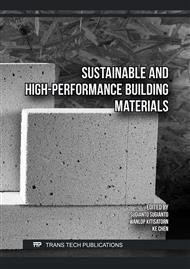[1]
J. Huang, R.B. Kogbara, N. Hariharan, E.A. Masad, D.N. Little, A state-of-the-art review of polymers used in soil stabilization, Constr. Build. Mater. 305 (2021) 124685.
DOI: 10.1016/j.conbuildmat.2021.124685
Google Scholar
[2]
P. Nitnara, P. Pongmuksuwan, W. Kitisatorn, Development of polymer binder for properties enhancement of soil cement, Mater. Today: Proc. 57 (2022) 975–979.
DOI: 10.1016/j.matpr.2022.03.334
Google Scholar
[3]
D. Mohan, Z.K. Teong, A.N. Bakir, M.S. Sajab, H. Kaco, Extending cellulose-based polymers application in additive manufacturing technology: A review of recent approaches, Polymers. 12 (2020) 1876.
DOI: 10.3390/polym12091876
Google Scholar
[4]
E.C. Ramires, J.D. Megiatto, A. Dufresne, E. Frollini, Cellulose nanocrystals versus microcrystalline cellulose as reinforcement of lignopolyurethane matrix, Fibers. 8 (2020) 21.
DOI: 10.3390/fib8040021
Google Scholar
[5]
A. Ashori, A. Nourbakhsh, Performance properties of microcrystalline cellulose as a reinforcing agent in wood plastic composites, Compos. B: Eng. 41 (2010) 578–581.
DOI: 10.1016/j.compositesb.2010.05.004
Google Scholar
[6]
N. Samat, C.D. Marini, M.A. Maritho, F.A. Sabaruddin, Tensile and impact properties of polypropylene/microcrystalline cellulose treated with different coupling agents, Compos. Interfaces. 20 (2013) 497–506.
DOI: 10.1080/15685543.2013.812767
Google Scholar
[7]
A. Cataldi, A. Dorigato, F. Deflorian, A. Pegoretti, Thermo-mechanical properties of innovative microcrystalline cellulose filled composites for art protection and restoration, J. Mater. Sci. 49 (2014) 2035–2044.
DOI: 10.1007/s10853-013-7892-6
Google Scholar
[8]
J.A. Lee, M.J. Yoon, E.S. Lee, D.Y. Lim, K.Y. Kim, Preparation and characterization of cellulose nanofibers (CNFs) from microcrystalline cellulose (MCC) and CNF/polyamide 6 composites, Macromol. Res. 22 (2014) 738–745.
DOI: 10.1007/s13233-014-2121-y
Google Scholar
[9]
F.A. Santos, M.I.B. Tavares, Development and characterization of hybrid materials based on biodegradable PLA matrix, microcrystalline cellulose and organophilic silica, Polimeros. 24 (2014) 561–566.
DOI: 10.1590/0104-1428.1653
Google Scholar
[10]
S.K. Bhattacharyya, A. Chakraborty, S. Ghosh, S. Dasgupta, R. Mukhopadhyay, A. Bandyopadhyay, Microcrystalline cellulose (MCC) as green multifunctional additive (MFA) in emulsion styrene butadiene rubber based high silica compound, Plast. Rubber Compos. 49 (2013) 393–400.
DOI: 10.1179/1743289813y.0000000061
Google Scholar
[11]
ASTM, Standard Test Method for Unconfined Compressive Strength of Cohesive Soil, United states.
Google Scholar
[12]
ASTM, Standard Test Method for Splitting Tensile Strength of Intact Rock Core Specimens, United states.
DOI: 10.1520/d3967-16
Google Scholar
[13]
A. Lukjan, A. Iyaruk, C. Petchprakob, Soil water retention curve and permeability function of the para rubber bio polymer treated sand, IRR. 15 (2020) 1–7.
Google Scholar
[14]
Y. Deng, X. Yue, S. Liu, Y. Chen, D. Zhang, Hydraulic conductivity of cement-stabilized marine clay with metakaolin and its correlation with pore size distribution, Eng. Geol. 193 (2015) 146–152.
DOI: 10.1016/j.enggeo.2015.04.018
Google Scholar
[15]
M. Haghighat, A. Zadhoush, S.N. Khorasani, Physicomechanical properties of α-cellulose-filled styrene-butadiene rubber composites, J. Appl. Polym. Sci., 96 (2005) 2203–2211.
DOI: 10.1002/app.21691
Google Scholar
[16]
S. Rios, R. Chlcurel, L.F. Del Castillo, Potential of particle and fibre reinforcement of tyre tread elastomers, Mater. Des. 22 (2001) 369–374.
DOI: 10.1016/s0261-3069(00)00103-5
Google Scholar
[17]
J. Wu, D. Qingjun, Y. Wen, W. Luoxin, W. Hua, Influence of submicron fibrillated cellulose fibers from cotton on hydration and microstructure of portland cement paste, Molecules. 26 (2021) 5831.
DOI: 10.3390/molecules26195831
Google Scholar



